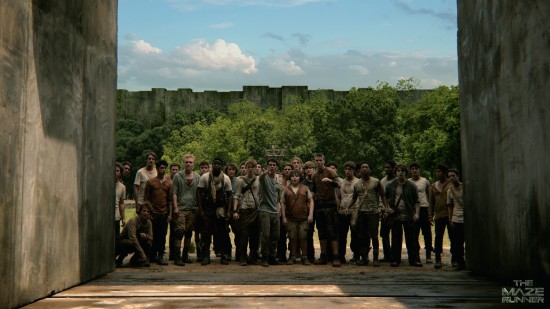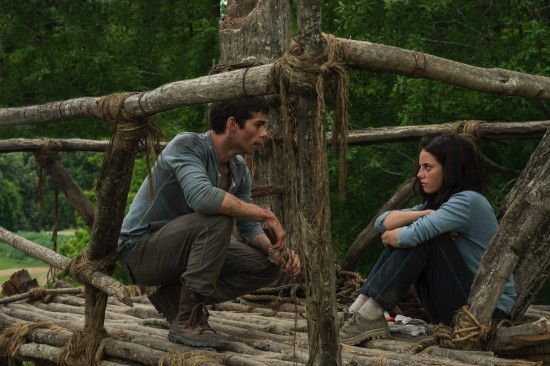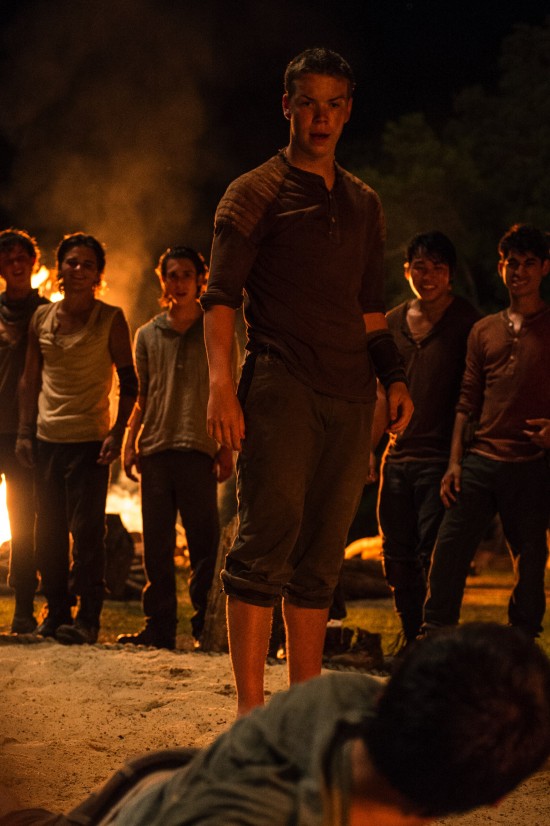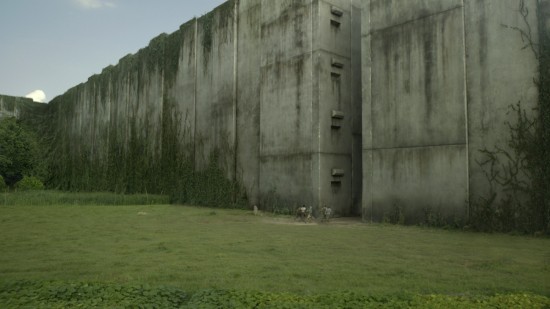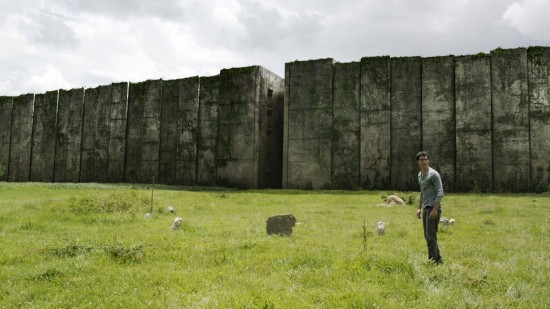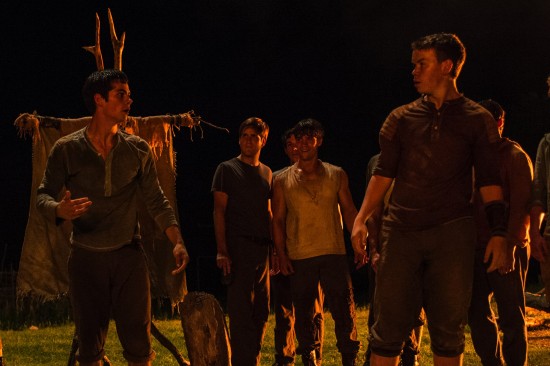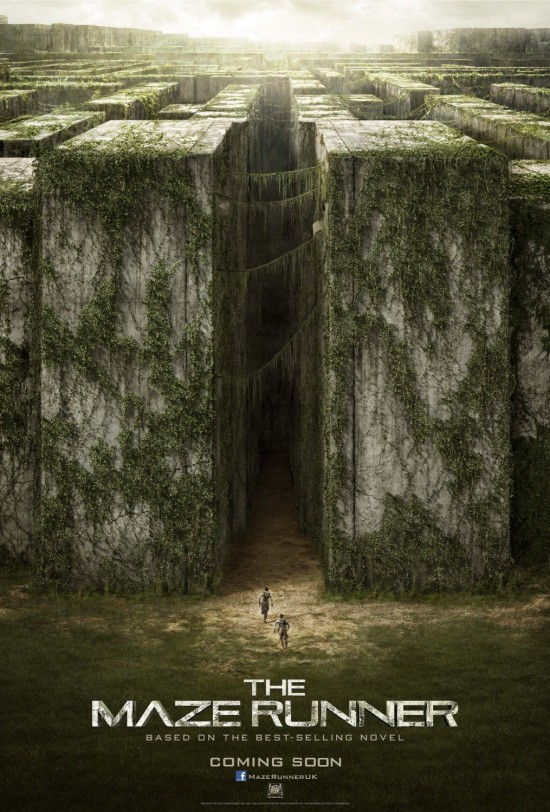50 Things I Learned On The Set Of 'The Maze Runner'
On June 4th 2013, I spent the night and early morning hours on a farm outside Baton Rouge, Louisiana, on the set of Wes Ball's upcoming movie adaptation The Maze Runner. Ball describes the film as Lord of the Flies meets Lost, so you know I am already very interested in this one. After the jump you can read about everything I learned about the movie while on The Maze Runner set.
The Story / Screenplay
The story follows a group of teenagers who are stuck in the Glade. That living space lies in the middle of a maze which opens up during the daytime, and closes at night. The first glader appeared from the elevator three years ago, and a new glader has appeared once a month since then. When the elevator comes up in a pit, alarms go off and doors open up.
The runners' job is to explore the maze and to find a way out. Take this line from the script description: "The runners look like war veterans that haven't gotten used to being back in civilian life."
Mino, the keeper of the runners, nominates new runners and those are held to a vote by the council.
The elevator comes up from the ground once a month, sometimes it even comes with food, seeds or tools. Teresa, who arrives later in the story, is the first and only female to come up from the elevator.
Wes Ball rewrote the script from scratch, and met with the author to get his thoughts on the adaptation.
Ball describes the story as Lord of The Flies meets Lost.
The movie is aiming for a PG-13 rating. West calls it "a kids movie with teeth" noting that it doesnt talk down to kids.
The relationship between Teresa and Thomas is not romantic. There is no forced kiss.
The screenplay is mostly true to the book, but features a few changes, including:
They talked to the author about the two main changes (the coma and telekinesis) and received his approval before production began.
The characters have a map room in their camp where they map out the maze even though it changes every night. They are trying to figure out a pattern.
Newt is the voice of reason, and is second in command. He is a nice approachable guy, doesn't have any animosity towards anyone. He has settled into life in the glade, but doesn't enjoy the entrapment. So when Thomas shows up with a different way of thinking it excites him even though he still has to enforce the rules of the community.
The first thing Teresa does when she wakes up is run to the lookout tree, from which she throws stuff at the boys.
The concept art of the Grievers shows them looking like a giant-sized flea, but with metal legs, stingers and dangerous appendages. The characters don't know how many grievers exist but, the production thinks the maze has around eight, one for each section of the maze. These creatures are organic but also mechanical, and are the size of a small truck.
During production the producers were considering doing digital short films featuring the backstories which appear in the second book. The shorts would be used as marketing for this movie.
The film will answer some of the questions posed by the concept of the story, but the ending will also introduce some more questions about "what has happened to the world" which will hopefully be explored in sequels.
The Set
We visited the set on day 16 of 42 shoot days, during an overnight shoot.
Most of the film is shot on 8 of the 2,000 acres of the Thompson farm in St Francisville / Jackson Louisiana, outside Baton Rouge. The day before this visit, we had visited the set for another Fox movie also filming in Baton Rouge: Dawn of the Planet of the Apes.
The camp set features a lookout tree, a tall treehouse-like lookout tower that allows them to see everything in the glade. The one thing this location lacked was the lookout tree. They ended up having to relocate another tree on the property as a result.
The production designer didn't want any of the huts to look like anything that would be beyond the creative abilities of these kids. He also had different teams create the different structures so that it wouldn't look like they were all created by the same person/people. Ideally, it may even look like they've learned and gotten better at certain aspects over time.
On the glade, they built a set of 20-foot tall, 40-foot wide doors, which will be augmented with set extensions to become 100 feet tall in the movie. The huge practical doors are operational. Each door weighs 5,000 pounds.
The names of all the "gladers" — the characters trapped in the central glade — who have existed are carved on the wall of the maze. Some of the names are crossed off, indicating that those characters have died.
The production employs a snake wrangler, who during the first 15 days of production had already caught 25 venomous snakes and another 35 non-venomous snakes. The biggest snake was a 5-foot rattler.
We witnessed the shoot of a big celebration, which in the story happens every time a new glader arrives. The celebration includes a big feast and huge bonfire. This particular sequence is when Dylan's character arrives, and begins to discover what the maze is about. Normally the maze doors open only during the day and the maze changes every night. But the doors don't close one night and the creatures beyond it, the grievers, are now a danger to the gladers. (It's a scene that takes place in the second half of the film.)
During another scene, a 20 foot tall bonfire blazes in the background. A couple dozen gladers circle two boys in the center, who are doing a fight dance. Thomas eventually comes to remember his name and the group comes in to embrace him. The celebration is cut short by a loud roar from the other side of the maze doors. Before filming the take, production played some tribal drum music over loudspeakers to set a mood. On set, director Wes Ball shouted "roar" through a megaphone for the actors to react to while watching from his monitors.
The Maze
The maze scenes will be filmed for nearly a month, created on stages at the end tail of production. The 160-foot by 80-foot stage used for the maze scenes was previously a Sam's Club store in Baton Rouge.
The maze built on that stage that has 16-foot tall walls that can be moved around. The production needed to create a very modular maze set so they can film all the different sequences with the same structural ingredients.
The maze consists of eight sections surrounding the inner part of the maze, with the glades in the middle.
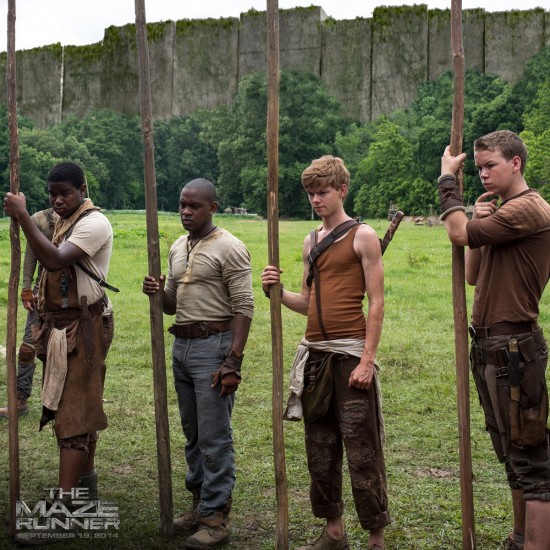
The first stage of the maze is called "the narrows." It is characterized by tight dark passages, with lots of ivy overgrowth and vines on the concrete walls. This part looks more like a traditional maze.
Once a maze runner gets through that stage, the maze opens up into "the surround". This is the portion which is divided into eight sections. Each section is numbered one through eight. The larger sections of the maze are very wide, reminiscent of the Los Angeles river, and even have some water.
The final stages of the maze are called sectors.
The Cast and Crew
Catherine Hardwicke was originally developing the film.
Director Wes Ball had a meeting at Fox to pitch a three-film epic film adaptation of his sci-fi short film Ruin. Ball calls that his Star Wars. After the meeting, they gave him the The Maze Runner novel. Wes came up with his take on it, bringing in many concept pieces he created himself. Emma ended the meeting by saying "great, you're our director." The next day he went into Fox and pitched Ruin and sold that in the room.
Casting directors saw thousands of people when casting this movie.
Wes Ball saw Kaya Scodelario on the UK television series Skins and wanted her from the beginning.
Dylan O'Brien almost didn't get the role because Wes thought his hair looked "too MTV." At the time, the actor was already starring in the MTV television series Teen Wolf. Wes eventually saw a photo of Dylan with more of a buzz cut and brought him back in.
The cast spent the week before production participating in survival training in the glade. They learned how to build tools and shelter out of the surrounding nature. They would also rehearse scenes during the bootcamp.
The filmmakers never tested the castmembers' physical abilities (i.e. making them run or jump) before the shoot.
The last night of the training was spent out in the glades together without any amenities. Wes came up with the idea of having the cast camp out in the glades one night before filming began, but the producer nixed it. The cast independently also came up with the same idea on their own. The night they camped out was marked by one of the biggest thunderstorms in the area's history.
During pre-production, Wes Ball kept getting tweets from a kid in Alabama who insisted he should play the role of Chuck. The kid was persistent and eventually Wes gave him the casting submission info. The casting director actually loved him, and Blake Cooper was cast as the character Chuck in the film.
The producer has three adolescent sons, each of whom had read all the Maze Runner books before he got involved. His kids told him if he didn't take the job they would kill him. He has shown his children some of the auditions and polled them about some of the possibilities, and admits it has been helpful.
Wes brought a unique vision to the project that didn't exist before he came on: "A graphic expanse and epic scope" that even the producers didn't have when they first read the book.
Wes Ball worked with a concept artist in Belgium to create the concept artwork for the film. Wes has never met him or spoke to him aside from in emails and IMs.
Wes Ball grew up one badge short of becoming an Eagle Scout.
The director referenced some work by Terrence Malick for some shots in this film.
Everyday Ball is told by producers that he needs to manage his expectations, but he insists on always shooting for the moon.
The crew got 36 setups done on the first day of shooting. One day they were rained out and lost 6 hours but still got 39 setups. Sometimes they are shooting with three cameras at the same time.

